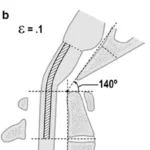Platybasia
What is Platybasia?
Platybasia is an abnormality of the base of the skull, literally flattening of the skull base. It may be developmental in origin or due to softening of the skull base bone, allowing it to be pushed upward (see Basilar Invagination).


What Causes Platybasia?
Platybasia is caused by degenerative conditions such as rheumatoid arthritis and other causes of hypertrophy of the odontoid [23, 29, 63, 66] in inherited conditions such as Ehlers-Danlos syndrome, Down syndrome, achondroplasia, osteogenesis imperfecta, Hurler’s syndrome, and from acquired bone-softening conditions such as rickets, hyperparathyroidism, spondyloepiphyseal dysplasia, acro-osteolysis, osteomalacia, achondromalacia, renal osteodystrophy, and Paget’s disease, in which abnormal bone remodeling causes bone weakening and subsequent platybasia and basilar invagination [19, 20, 69, 70, 104, 112].
Platybasia also can be seen with congenital (craniofacial anomalies, osteogenesis imperfecta, cleidocranial dysplasia, Chiari malformation, etc.), or acquired conditions (osteomalacia, rickets, trauma, etc.) Reference
It is sometimes associated with other congenital abnormalities of the bone structure, such as fusion of the first cervical vertebrae to the skull (atlas assimilation). Reference
Platybasia is often associated with any condition in which there is widespread disease of the brain and spinal cord from herniation or displacement of the medulla oblongata, which is essentially the continuation of the spinal cord within the skull, forming the lowest part of the brainstem (and contains the control centers for the heart and lungs.). It is also referred to as medullary kinking. [24, 47, 49, 103, 129, 140]
What are the symptoms of Platybasia?
In the absence of neural compression, pain at the back of the skull and upper part of the neck is the most common symptom. Neural compression may affect the medulla and nerve roots from the lower brainstem, particularly those that might affect swallowing and the cough reflex. Reference
Are there any associations with Platybasia?
Basilar invagination can present with Platybasia. Basilar Invagination is a congenital or acquired craniocervical junction abnormality and where the tip of the (C2 dens) odontoid process projects through the small opening at the base of the skull (foramen magnum).
Platybasia may therefore signal the presence of a pathological CXA.

